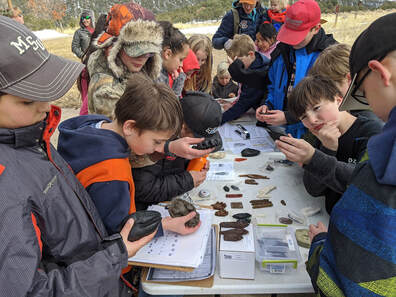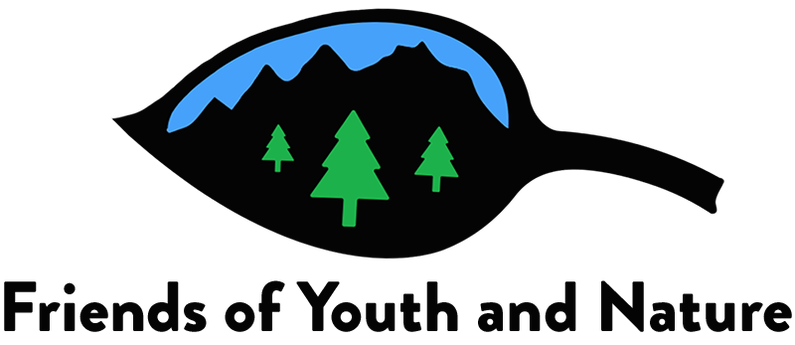|
Tips to help you connect your family to nature!
|
|
Like the pages of a book telling a story, the tracks, trails and impressions in the snow reveal the activities of animals in your neighborhood. Each type of animal has unique tracks which reveal a lot about their lifestyles and habits.
By discovering tracks, scat, and other signs of wildlife in snow, you can turn a winter hike into a treasure hunt for your child. Select a snowy area where you are likely to find an assortment of animal tracks, and keep the hikes short and leisurely. Fresh snow early in the morning is best, before tracks melt away. Imagination is key! Animal tracking combines science, creativity, and storytelling. You won’t see the animal itself but the tracks they leave behind are pieces of the puzzle for you to solve. What kind of animal made the track, and what was it doing? Where did they come from, and where were they going? Prompt your child’s curiosity and help sharpen their observation skills. To identify a track start by counting the toes. If it has two toes, it’s probably a deer, elk or moose. If it has four toes and a heel pad, it could be a bobcat, lynx, or mountain lion; it could also be a canine like a fox, coyote, or dog. The easiest way to tell a cat from a dog track is the presence of nails. Cat’s toenails are critical for catching prey so they keep them retracted for protection when not in use. Most canine tracks, on the other hand, have visible nail marks above their pads. Five toes? It could be a raccoon, or another animal that uses its paws like hands. Next, take a good look at the size and how deep the tracks are in the snow. A mouse is smaller than a squirrel. A smaller and lighter animal will leave a shallower impression. Show your child how much deeper your tracks are compared to theirs. Among the big cats, a bobcat track is smaller (and likely more shallow) than that of a lynx or a mountain lion, with the mountain lions’ being the biggest print − almost the size of an adult fist. Lynx tracks can be distinctive because their tracks have hair impressions around the pads. Dog and coyote tracks look similar, but coyote tracks are narrow and diamond shaped while dog tracks are rounder with more space between the pads. Fox tracks are shaped like a coyote but much smaller. Another clue is the animals stride or the repeating pattern of their prints in the snow. Animals walk in four basic patterns: walking, galloping, bounding and pacing or waddling. Those patterns are influenced by the length of an animals legs and their overall body shape. A walking pattern is characteristic of animals with long legs like a cat, dog, coyote, deer or elk. These animals are very efficient and will often place their back foot on top of where their front foot was. Their stride pattern is a series of single prints generally in a straight line. Squirrels, chipmunks, mice, rabbits and snowshoe hare are gallopers because they leap from one location to another. Rabbits and squirrels are similar in that their larger hind paws land in front of the smaller front paws, making four distinct prints per track− two parallel long prints in front of two small round prints. Tracks of snowshoe hare are similar to rabbits but much larger. Look for the round toe impressions of rabbits compared with the long finger marks of squirrels. Bounders are animals that have a bounding stride like weasels, mink and otters. Their front paws hit first and then their back paws land where their front paws were. Their tracks appear as two paws that fall side-by-side. Weasels often drag their tails, leaving a central furrow. Pacers or waddlers are short–legged, heavy-set mammals (beavers, porcupines, raccoons, skunk, and bears) that have a distinctive track with four paw prints. They waddle, shifting their weight to the right so their left front/back paws can move forward, then shift their weight to the left so their right front/rear paws can move forward. You can’t miss a bear track – its paws are huge with five rounded toes and a wide heel pad. Don’t forget bird tracks. You can usually only see their footprints, but sometimes you can see the wing marks where one landed. Take a look at the bigger picture surrounding a set of tracks. Look at the direction of the tracks, and where they end up. A good tracker will be on the lookout for other clues such as blood and/or wing marks indicating maybe a hawk caught something, a spot where an animal burrowed, seeds of a pine cone scattered about (squirrel lunch), or yellow snow− animals pee too! If you want to expand your identification skills, there are apps to help you such as iTrack Wildlife Apps by Nature Tracking. All are easy to use, contain high resolution photos with detailed information and work offline. Remember to be safe. If you spot the actual animal, give it space and an escape route. Always observe from a distance. If you are causing a change in their behavior, you are too close! Whatever tracks you and your child find are clues to an awesome winter treasure hunt, and will spark wonder and discoveries about the animals in your neck of the woods!
2 Comments
12/19/2021 09:43:25 am
Nicе post. I was cheϲking constantly this weblog and I’m insρired!
Reply
Leave a Reply. |
Blogs for Summer! DIY Summer Camps A Summer backyard Bucket List Hiking with Children 101 Kids, Dogs and Hikes a Winning Combination Getting Outdoors is Easier than You Think Categories
All
Archive
Archives
July 2024
|



 RSS Feed
RSS Feed


